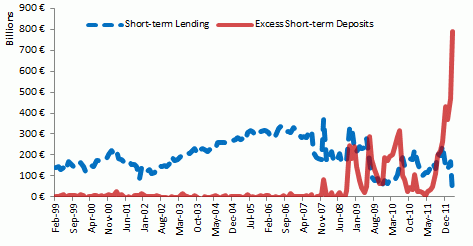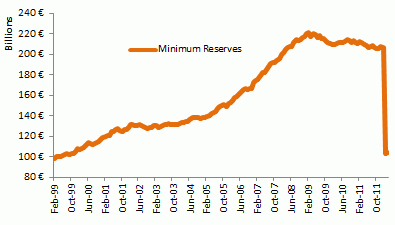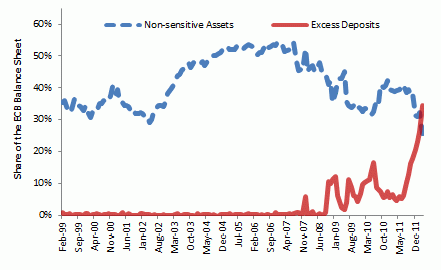In December, the ECB successfully forestalled a financial crisis by stepping in with a big bazooka and inundating the market with liquidity. Unfortunately, the big bazooka has come at a cost; the composition of the ECB’s balance sheet has changed dramatically.
Under standard monetary policy, when there is a sudden increase in money growth, the central bank can increase its short-term interest rate and thereby reduce its short-term loans to banks. This policy causes a reduction of bank lending to households and firms, which absorbs excess liquidity and prevents an acceleration of inflation. The ECB has lost its ability to implement this type of anti-inflationary policy.
As seen in Figure 1, the short-term deposits of banks at the ECB in excess of the minimum requirements – the so-called excess reserves – have experienced an unprecedented increase: from €199 billion in September 2011 to €792 billion in March 2012. These short-term excess reserves can be withdrawn by banks in a sudden manner and now represent 26% of the ECB’s balance sheet.1, 2
Figure 1. Excess short-term deposits vs short-term lending at the ECB (in billion euros)
Note: The solid red line depicts banks’ short-term deposits at the ECB, in excess of the minimum reserve requirement. The broken blue line depicts the ECB’s short-term lending to banks. The last data point corresponds to the 10th week of 2012.
If banks chose to withdraw their deposit or inflation started for any other reason, could the ECB follow the standard policy and raise short-term interest rates? No, because this policy instrument is not available to the ECB anymore; its short-term lending to banks has practically hit zero. It has collapsed from €201 billion in September to €18 billion in March. Presently, the ECB’s short-term loans to banks represent only 0.6% of its balance sheet.
In principle, the ECB could take other actions to absorb an excessive increase in liquidity. It could:
- Increase minimum reserve requirements;
- Sell assets other than its short-term loans to banks; or
- Increase the interest rate on bank deposits at the ECB to discourage banks from making withdrawals.
Let us consider each in turn.
Is the ECB likely to increase the minimum reserve requirements in the foreseeable future? The short answer is no. In fact – as part of the big bazooka – the ECB reduced the minimum reserve ratio from 2% to 1% on 8 December 2011. As a result, minimum reserves fell by a remarkable €104 billion in February 2012, as shown in Figure 2.3
Figure 2. Minimum reserves at the ECB (in billions of euros)
Note: The last data point corresponds to the 10th week of 2012.
In the next few years, the ECB will find it exceptionally difficult to increase minimum reserve requirements because there is a sharp asymmetry of excess deposits across countries. While in some countries the excess of deposits over minimum reserves is quite high (eg €313 billion in Germany), in other countries there are practically no excess deposits (eg €1.5 billion in Italy). Therefore, if the ECB were to increase minimum reserves, there might be systemic bank failures among these low excess-deposit countries. Since the ECB cannot discriminate by increasing minimum reserves for some countries while not for other countries, it will likely keep minimum reserves at low enough levels so that none of the countries risks a liquidity squeeze.4
Could the ECB instead sell other assets in its balance sheet to mop up liquidity? To illustrate why it will not be easy for the ECB to do so, let’s consider a generous rule which permits the ECB to dispose of all its assets at short notice, except those ‘sensitive assets’ that are clearly difficult to dispose of. As Figure 3 shows, even under our assumed scenario, this upper bound on the share of ‘non-sensitive assets’ that the ECB could sell at short notice has fallen to 26% of the balance sheet. Considering that total excess deposits amount to 34% of the balance sheet, the ECB would not have enough non-sensitive assets to sell in order to cover a withdrawal of excess deposits by banks. March 2012 is the first time since the creation of the ECB that the upper bound on non-sensitive assets is below excess deposits. Clearly, the ECB has hit a critical limit.
Figure 3. 'Non-sensitive' assets vs excess deposits (ECB balance sheet shares)
Note: The solid red line is the share of banks’ total deposits at the ECB in excess of the minimum reserve requirement. The broken blue line is the upper bound on the share of ‘non-sensitive assets’ that the ECB could sell at short notice, which include ‘other securities,’ ‘other assets’ and ‘main refinancing operations’. The last data point corresponds to the 10th week of 2012.
Consider the list of sensitive assets.
- First, the ECB cannot reduce its stock of €1,100 billion ‘longer-term refinancing operations,’ which represent 37% of its balance sheet. This was the main component of the big bazooka and matures in 2015.
- Second, the ECB cannot easily sell the ‘securities held for monetary policy purposes’, which represent 9% of the balance sheet. Despite their name, these securities comprise mainly the government bonds that the ECB bought via the Stability Market Program and the Covered Bonds Purchase Program to help banks during the 2008 crisis. If the ECB were to sell these securities, longer-term interest rates in crisis countries would increase significantly. Moreover, the ECB would experience explicit capital losses.
- Third, the ECB cannot reduce the Emergency Liquidity Assistance included under the ‘other claims on Eurozone credit institutions’ (2% of the balance sheet).5
- Fourth, it is unlikely that any of the 17 national central banks that comprise the Eurosystem will choose to reduce their holdings of gold (14% of the balance sheet), their international reserves (8% of the balance sheet), their dollar loans to domestic banks or euro-loans to foreign banks (3% of the balance sheet), or their ‘government bonds’ (1% of the balance sheet). If the fourth option were undertaken, the ECB would face the difficult decision of determining which countries should sell assets and which should not.
Under the generous rule scenario we are considering, the assets that the ECB can easily dispose of include ‘other securities’ (11.7% of the balance sheet), ‘other assets’ (13.5% of the balance sheet) and the ‘main refinancing operations’ (the short-term loans to banks depicted in Figure 1, which are 0.6% of the balance sheet). The ‘other securities’ and ‘other assets’ categories may or may not contain assets whose price is sensitive to short-notice disposal. The ECB is not transparent on the contents of these parts of its balance sheet.6
The third option, increasing ECB interest rates on bank deposits sufficiently to stem an exodus of withdrawals, does not seem realistic. In fact, excess deposits are typically zero in normal times. Moreover, high enough interest rates on deposits – without a higher lending rate – might generate losses at the ECB, which is a politically sensitive issue.7
In summary, the intersections in Figures 1 and 3 make clear that the ECB has lost its ability to implement standard anti-inflationary policies. It is in this sense that Draghi’s statement is brave.
The fact that the ECB has hit a limit does not mean that inflation will flare up soon. It does, however, mean that the ECB’s space to manoeuvre has become narrow.8 This lack of maneuvering space will induce an inflationary bias in monetary policy: At the margin, the ECB will find it costlier to hit the anti-inflationary brakes than to push the monetary accelerator. This bias puts the Eurozone at risk of de-anchoring long-run inflationary expectations. The danger is not inflation today, but the de-anchoring of expectations about future inflation.
Addendum (12 April 2012)
Response to Thimann’s column “ECB Inflation-fighting powers remain intact”
In a recent Vox column Christian Thimann (2012) responded to our column. Here, we would like to emphasise that his column is not contradictory to ours. Thimann talks about technical feasibility, while we talk about likely best-responses of the ECB to prevent inflation if banks were suddenly to withdraw their excess deposits from the ECB or if inflation accelerated for any other reason.
Thimann’s main points are that, if banks were to withdraw their excess deposits at the ECB, then the following tools could be used:
- The ECB could increase its longer-term policy rates, including the interest rates it charges on the €1000 billion three-year loans it extended to banks last December and February.
- The ECB could issue debt certificates and tender long-term deposits to mop up liquidity. That is, instead of selling existing assets, the ECB can issue new liabilities.
Technically, it is feasible to increase longer-term interest rates. But, is it realistic to assume the ECB would actually find this to be a best response? Furthermore, how high would longer-term interest rates have to increase to prevent banks’ withdrawals?
Although technically feasible, interest rate increases on the ECB’s long-term loans are unrealistic. To see why, notice that there is a sharp asymmetry across countries ofbothexcess deposits and ECB loans. While in some countries the excess of deposits over minimum reserves is quite high (eg more than €300 billion in Germany), in other countries there are practically no excess deposits (eg almost zero in Italy). Therefore, if banks in an excess-deposit country suddenly withdrew their deposits and the ECB responded by increasing sufficiently longer-term interest rates on loans and deposits, then it might generate a liquidity squeeze in countries with weak banks where a significant share of ECB long-term lending took place – eg Italy and Spain.
In other words, the ECB should guard against an asymmetric inflationary shock, eg sudden bank withdrawals in high-excess-deposits countries combined with an economic weakening in countries with high ECB loans. Higher long-term interest rates would not be a best response to such an asymmetric shock.
Regarding the second tool, we agree that the ECB can issue debt certificates – ie ECB bonds – without parliamentary authorisation. In principle, to ensure enough banks subscribe to the debt certificates, the ECB can offer a high-enough interest rate. Thus, technically this non-standard tool could be effective. Notice, however, that the large-scale issuance of ECB bonds may be politically sensitive. Thus, if the ECB were to issue debt certificates to mop up liquidity, it is likely to hit another political limit in the amount of such bonds it issues.
In sum, although technically possible, the ECB will find it exceptionally difficult to increase interest rates on its long-term loans to banks. In this regard Thimann notes: “Whether this [ie,an increase in the deposit facility rate]would be an appropriate way to signal a change in the monetary policy stance, is a decision by policymakers; technically, it would be feasible and effective.”
References
Thimann, Christian (2012), “ECB Inflation-fighting powers remain intact”, VoxEU.org, 30 March.
1 A less conservative number would result if long-term deposits were counted as part of the minimum reserves. Calculated in this manner, excess deposits would now be €1,036 billion or 34.5% of the balance sheet.
2 In the recent past, sharp increases in bank excess reserves at the ECB have been followed by sudden and sharp reversals, as can be seen in Figure 1. This was the case in 2008 after markets calmed following the bailout announcement; in 2009 after Ireland accepted the bailout; and in 2010 after the 1st Greek bailout was announced.
3 The ECB argued that “as a consequence of the full allotment policy applied in the ECB’s main refinancing operations and the way banks are using this option, the system of reserve requirements is not needed to the same extent as under normal circumstances to steer money market conditions.”
4 Arguably, in the US it would be easier for the FED to respond to a sudden withdrawal of excess reserves by increasing minimum reserves because if some – small – banks were to fail, other banks with excess reserves at the FED could take them over. However, in the next few years, such takeovers are not likely in Europe as they would entail cross-border mergers. Therefore, unlike the FED, the ECB is unlikely to increase minimum reserves.
5 The Emergency Liquidity Assistance (ELAs) are unsecured loans given to Greece and Ireland.
6 To construct the upper bound on the share of non-sensitive assets that the ECB could dispose of at short notice we have made the extreme assumption that all assets included in ‘other securities’ and ‘other assets’ could be disposed of at short notice. The true share might in fact be smaller.
7 In the future, there might be a fourth possibility. Once the ESM is fully operational, the ECB could either sell its sensitive assets to the ESM or unload them into the market, with the expectation that market participants could then resell them to the ESM. In either scenario, the ECB might avoid losses, but the taxpayers would not. Essentially, it would be a roundabout capital injection to the ECB financed by the taxpayers.
8 According to Draghi: “The banks to which the ECB has lent the money have, by and large, not fed this into the economic cycle but have used it to meet old liabilities. So the money in terms of inflation has, so to speak, been neutralized. This action is not inflationary. And we will watch very carefully if and how the money is fed into the economic cycle”. A similar statement was made by Peter Praet, chief economist at the ECB, who added: “we have all necessary instruments to counteract” inflation if it arrives. The problem is not that inflation has accelerated today, but that the various components of the big bazooka – the €1 trillion cheap three-year loans to banks, the relaxation of collateral constraints, and the reduction in reserve requirements – have eliminated several instruments to fight future inflation. Praet’s statement is in a FAZ interview on 25 March.





